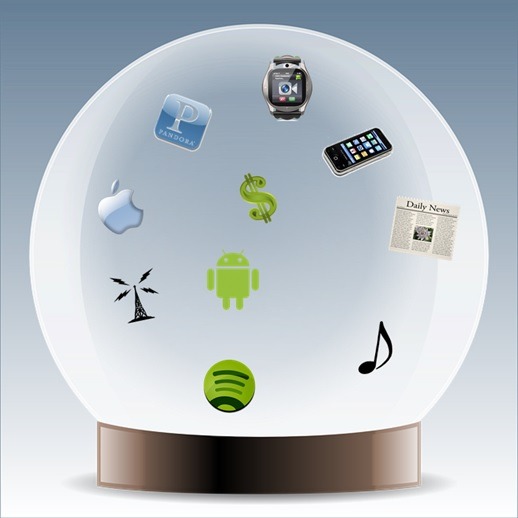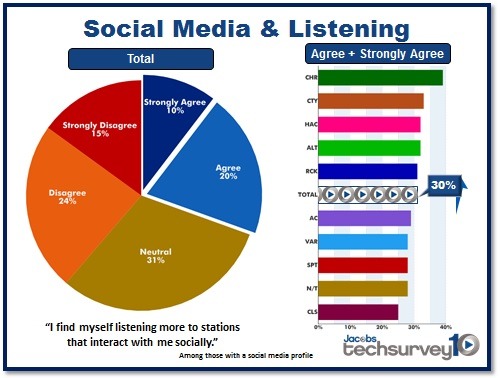Not to start the new year on a down note, but a new report in NetNewsCheck (whose positioning statement is “The Business of Local Digital Media”) features their “10 Local Digital Media Trends For 2015.” Now end-of-year lists are a dime a dozen – especially those that attempt to predict what will happen.
(After all, who could have predicted that 2014 would be the year of Classic Hip-Hop?)
Editor Michael Depp steps out with his vision of what’s to come on the local digital media horizon, and some of his calls are interesting, if not a bit chilling. For example, his first out-of-the-box statement is that the new year will find local TV and radio stations in “the most precarious position they’ve been in for a long time.” He blames their predicament on “slow and deeply unimaginative moves in digital.”
Maybe so. But deeper in his analysis are some interesting observations about how local broadcasters can use their resources to counter the digital tide. One point about the growing “beacon” technology as a digital sales tool caught our attention because it’s been a topic in this blog last year, penned by jācapps COO Bob Kernen.
As Depp predicts, “Beacons will open up a new flank on mobile monetization.” If you haven’t taken a deep dive into beaconing, you should. Because it’s where the confluence of retail business, mobile, and broadcast radio might come together to unpack dollars and results for all parties. We will be on the lookout for beaconing technology this week at CES in Las Vegas.
Depp also points to “programmatic buying” as another big trend on the horizon. As he notes, “The stigmas around programmatic buying will fall away.” We saw this loud and clear in last year’s “Radio’s Most Innovative” post that focused on Mike Dougherty’s Jelli. As Mike explained back in November, “We’re trying to enable radio to have elements that are similar to digital so it’s both easy to use and reaches a person in their car, a place it’s been historically difficult to reach with digital buys.”
But it was Depp’s third prediction that caught my attention because it has been a theme at Jacobs Media for several years now, amplified by Lori Lewis joining our company:
“Data will show a positive correlation between social media use and Nielsen ratings. Want to talk to an audience? You find them on social. Those broadcasters who use these platforms well will invariably find themselves evolving in tune with what their audiences really want and care about. Their programming will be more relevant, their engagement much stronger and their proposition to advertisers hugely more valuable. Look for more and better quantification of this in studies this year, and look for the execs who are shaking their heads in incredulity at this thought to lose their jobs shortly after.”
During Lori’s first year at Jacobs Media back in 2012, one of her top concerns was broadcast leadership taking social media seriously. Virtually no one doubted the scale of social, highlighted by the massive legions of consumers signing up on Facebook and Twitter, and later Instagram, LinkedIn, Pinterest, and others. But there has always been a great deal of skepticism, a stigma, and even misguided thinking about social media’s purpose.
The “How do we make money from social media?” mantra became popular, obscuring the focus on what consumers were truly looking for from their social media relationships with brands like radio stations.
While many in radio have improved their social skills over the past few years, there is still a chasm between how consumers view social media and how broadcasters (and other brand managers) perceive and use it.
Lori’s qualms have to a great degree been put to rest, and many broadcasters are now taking social media more seriously. But only a handful are utilizing it strategically, intuitively, or wisely. This may be due to the fact that social is truly about what audiences are thinking, feeling, and doing – and not necessarily about what programmers are creating or what reps are selling.
A big part of radio’s challenge with social media is one of orientation. Thinking back on the typical “radio education” that most of us had, fledgling broadcast professionals were dutifully taught how to run a tight board, create a sale piece, schedule a day’s music, and set up an advertiser remote. But few were instructed in the art of listening to the audience, offering true customer service, and looking at the world from the consumer’s point of view.
The “We broadcast-you listen” model may have served radio well for decades, but todays’ social media culture has swung the pendulum of modern marketing back to the consumer.
The good news for radio is that as Depp points out, there is a growing relationship between social engagement and media consumption. Brands that truly offer a unique connection with consumers have the ability to increase listening and loyalty.
We saw that in Techsurvey10 and we will be trending this information in our upcoming study later this month (to sign up, click here). For a sizable portion of the radio audience, being acknowledged socially is the “gateway drug” for increased listening.
Depp’s threat that execs that don’t buy into social media are doomed to obsolescence may be a bit extreme. But a corporate understanding that the very foundation of media engagement and the ways in which people connect with brands (and each other) have been altered by these social platforms is now a necessity. Recognition of this sea change is a first step in reevaluating the ways that radio stations interact with the people who support them – with their quarter hours, their advertising dollars, and their loyalty.
Using social media as that connective tissue that brings together audiences, advertisers, and brands shouldn’t be viewed as a burden or an expense, but as an opportunity.
Here’s hoping for a satisfyingly social new year for radio.
- Media And Technology In 2025: Believe It Or Not! - April 18, 2025
- In Radio, You Just Never Know - April 17, 2025
- The Secret To Making A Great Podcast (And Great Radio) - April 16, 2025






Leave a Reply